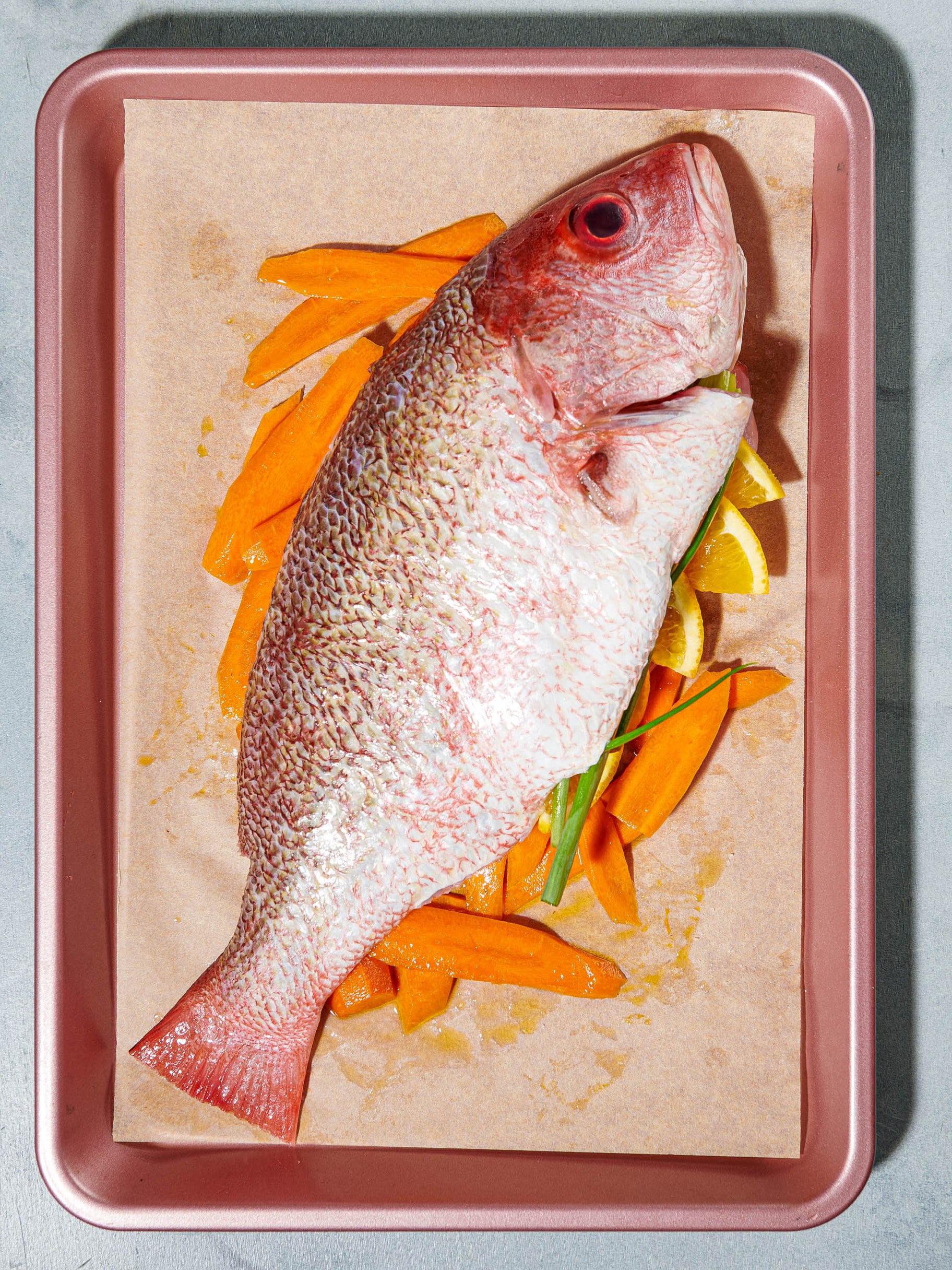
The fish stared back at me, eyes wide and shining, fins limp and wet. Still half-wrapped in paper, its gut hollow, it was the first whole fish I’d brought home to cook, and it forced me to reckon not just with dinner, but with life and death.
“Culturally, we’re not a country that spends a lot of time eating whole fish. We’re not conditioned to do it; we’re a fillet-eating society,” chef Ricky Moore, who runs a seafood restaurant, tells me by phone. “Most places abroad, eating whole fish is standard, it’s normal.”
“Growing up, we didn’t eat fillet fish,” Moore says, noting that he comes from “a long line of fisherfolk”.
“Our philosophy was, fisherfolk don’t catch fillets, we catch whole fish.” So, cooking whole fish is a more obvious approach in Moore’s mind. “I think it’s the most natural way to celebrate good fish, personally, from a preparation standpoint, and a textural standpoint,” he said.
Between supermarket rotisseries and home-cooked birds, we roast a lot of chicken at home, but processors cut their heads off so we don’t have to look them in the face. There’s an intimacy in looking into another’s eyes, doubly so when its death means it’s crossed over from fellow animal to food. For a lot of human existence, this feeling was described in terms of dominion or disgust. For the past couple of decades, I’ve tried to approach it with humility.
If you eat fish, but you’ve never cooked one whole, tonight might be the night to give it a go. Whole fish are often less expensive than fillets, and roasting one is at least as easy as roasting a chicken or large cut of meat.

“Simplicity is the key,” Moore advises. First, have your fishmonger clean it, descale it and trim the sharp fins. At home, bring it to cool room temperature, season it, stuff the cavity, and get ready to cook it at high heat, somewhere between 190-230C. The trickiest part is knowing when it’s done.
How to tell when it will be buttery, not dry? “Checking for the degree of doneness is universal,” Moore says. “Find one of the dorsal fins. If it pulls out easily, then the fish is done.” As with all proteins that are cooked bone-in, there will be some carry-over cooking, so you’ll want to consider resting time, too.
This recipe calls for a whole bass or snapper, which gets seasoned, stuffed and roasted on top of courgette or carrots for a traybake meal. Once out of the oven, you’ll drizzle the fish with pomegranate molasses, a sweet-and-tangy slip of a sauce that gives even the mildest fish lots of flavour (look for it near the honey in your supermarket, or at Middle Eastern or Indian grocers). A sprinkle of pistachios adds a finishing touch of crunch.
Of course, you can get a whole fish without its head – any fishmonger will gladly chop it off – but if I’m buying a fish to cook whole, I wouldn’t want to: I want to look into its eyes, see their clear sheen. Especially if I didn’t catch the fish myself, that’s proof that it was swimming not too many hours before, proof that it’s going to smell and taste like the clean, salty sea.
Whole roasted fish with pomegranate molasses
Active time: 20 minutes | Total time: 50 minutes
Serves: 2 to 4
Flavours from the Middle East – tangy pomegranate molasses, earthy pistachios – inspired this whole roasted fish. Look for fresh whole snapper or any kind of bass. Letting the fish come to room temperature before roasting helps ensure it cooks evenly. Spring onions and orange slices stuffed into its cavity infuse the fish with lots of flavour. Roast it over thinly sliced vegetables for a full traybake meal.
To expedite the recipe, set the fish out to come to room temperature while you prep the remaining ingredients.
Not a fish eater? Try this with firm tofu marinated with spring onions and orange slices. Chicken thighs are another option.
Can’t find pomegranate molasses? Use a mixture of equal parts honey and lime or lemon juice.
No pistachios? Pumpkin seeds or toasted sesame seeds would be nice here.
Storage notes: Leftovers can be refrigerated for up to 1 day.
Where to buy: Pomegranate molasses can be found at well-stocked supermarkets and Middle Eastern markets.
Ingredients:
One (680-900g) whole snapper or bass, cleaned and descaled
1 small orange
1 medium courgette or 2 large carrots (about 340g total), thinly sliced
2 tablespoons olive oil, divided, plus more as needed
Fine salt
2 spring onions, trimmed
2 tablespoons pomegranate molasses, plus more for serving
2 tablespoons shelled, toasted pistachios, preferably lightly salted, chopped
Method:
Set the fish on the counter to let it come to room temperature before cooking.
While the fish comes to room temperature, using a vegetable peeler and trying to avoid the bitter white pith underneath, remove one small strip of zest from the orange. Slice the orange zest into thin strips and set it aside for garnish. Halve the orange and slice one half into thin half-moons (reserve the remaining orange for another use).
Position a rack in the middle of the oven and preheat to 230C.
On a large, rimmed baking tray, toss together the sliced courgette or carrot with 1 tablespoon of olive oil and spread the slices evenly in the centre of the pan; it’s OK if they overlap slightly. Season lightly with salt.
Oil the fish with the remaining olive oil, using more if needed, and season lightly with salt inside and out. Stuff the cavity with the orange slices and spring onions. Depending on the size of your fish, all of the fillings might not fit; reserve any excess for another use. Lay the stuffed fish atop the vegetables in the centre of the pan. Roast, rotating the pan once halfway through cooking, for 20 to 30 minutes, or until the skin is crisp and visibly puffed and a thermometer inserted in the thickest part of the head reads 57C.
Allow the fish to rest for 5 to 10 minutes before serving.
To serve, using a thin spatula or large spoon, carefully transfer the top fillet to a plate (see note). Discard the skin, if desired.
Drizzle with half of the pomegranate molasses and sprinkle with half of the pistachios and orange zest. Grasp the tail and pull it up to remove the bones from the center of the fish. Transfer the remaining fillet to a plate and garnish with the remaining pomegranate molasses, pistachios and zest.
Serve with the roasted vegetables and additional pomegranate molasses on the side.
Note: Have a serving plate or platter ready. Remove the pin bones along the back of the fish by cutting away the dorsal fin – follow the line of the fish’s back from just below the head to the tail.
Separate the head and collarbone from the top fillet, following the line where they meet and cutting about halfway through the fish. Do the same with the tail. Slide a thin, metal spatula under the top fillet to separate the meat from the spine, and slide the fillet onto the plate.
Grasp the tail, and pull it up to remove the bones from the centre of the fish, which should also remove the head. Transfer the remaining fillet to a plate and garnish with the remaining pomegranate molasses, pistachios and orange zest.
Nutrition information per serving (½ fillet), based on 4 | Calories: 284; total fat: 11g; saturated fat: 2g; cholesterol: 63mg; sodium: 192mg; carbohydrates: 8g; dietary fibre: 2g; sugar: 6g; protein: 37g.
This analysis is an estimate based on available ingredients and this preparation. It should not substitute for a dietitian’s or nutritionist’s advice.
© The Washington Post







